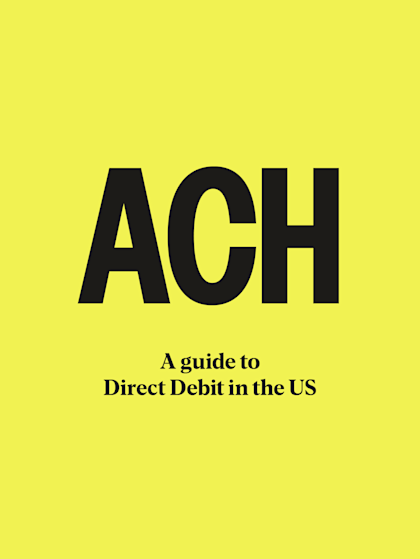
Paper vs. Paperless Direct Debit
Last editedApr 20232 min read
Direct Debit - also known as ACH Debit or bank debit - can be done via paper, or paperless. Here's a comparison to help you decide which is best for you.
Paperless Direct Debit is set up over the phone or online, while paper Direct Debit uses paper mandate forms. To help you decide which one is best for you we’ve compared them below.
Customer acquisition
Paper – Getting a signed form is a simple way to get authorization where you already meet with your customers in person. It isn’t so good where you don’t – your customer will have to download and print a form to sign, before posting it back to you. Plus you'll need to manually process the Direct Debit mandate before storing it securely.
Paperless – If you sign up customers online or over the phone, you will benefit from a paperless Direct Debit solution. Alternatively, if you sign customers up in person, you may prefer to set people up using a tablet or mobile device. Getting paperless authorization avoids the need for manual processing. However, to use paperless Direct Debit, you'll need access to an online device at the point of sale.
Summary: Paperless is the simplest option, unless you don’t have easy access to an online device at the point of sale.
How to collect Direct Debit payments with GoCardless
1.
Create your free GoCardless account, access your user-friendly payments dashboard & connect your accounting software (if you use one).
2.
Easily set up & schedule Direct Debit payments via payment pages on your website checkout or secure payment links.
3.
From now on you'll get paid on time, every time, as GoCardless automatically collects payment on the scheduled Direct Debit collection date. Simple.
Customer preference
Paper - Customers without access to a computer, or those who don't want to use the internet for payments, or give out personal information over the phone may prefer paper mandates.
Paperless - Many customers prefer the convenience of setting up payments online or over the phone.
Summary: Paperless is simpler, however it may not be a fit if your customers aren’t comfortable using computers or the internet. We sometimes see this with businesses whose customer base is not computer literate.
Storage
Paper - All mandates need to be stored. You will need to produce it in case of an indemnity claim. You will need an in-house or remote storage solution, and someone to manage it. You will also need to create and maintain an electronic database of the mandate information.
Paperless - Paperless mandates do not need to be stored physically, as there is no physical document. You will just need an electronic database of the data and log of the signup. This helps to reduce storage and administrative overheads. However, the lack of a physical document can make proving authorization more challenging in case of an indemnity claim. However, this risk is typically small.
Summary: Generally, paperless is the better option, as it saves time and effort. However, if you have a high average transaction value, and are concerned about chargebacks, then paper may make sense.
Process
Paper – Paper mandates are slower to set up, and more susceptible to human error. Customers may need to post their mandates to you, and you will need to manually re-key the data into your database.
Paperless - Paperless mandates involve fewer manual processes. Customers can sign up instantly online or over the phone, and the data is entered directly into your database.
Summary: Paperless is less open to human error and customers can sign up quickly. This means you can start taking payments earlier.
Cost
Paper - Paper Direct Debit involves printing, postage, and storage costs. Setting up payments and sending notifications by post is expensive and can cause delays which further cost your businesses money.
Paperless - Paperless mandates are cheaper to set up, as they use an electronic process. This avoids the cost and inconvenience of printing, signing, and posting paper forms. However, depending on your Direct Debit provider, you may need to pay an additional monthly fee to use paperless services.
Summary: Paperless avoids the costs associated with printing, posting and storing paper mandates. Even with potential costs for accessing the paperless system, this likely remains a significant saving.
Overall summary
Paperless Direct Debit is quicker, easier, and cheaper than using paper. Increasingly customers prefer to set up payments online or over the phone. However, some customers continue to prefer a traditional paper set up - such as elderly customers - so you should consider the preference of your customer base before making the decision.

